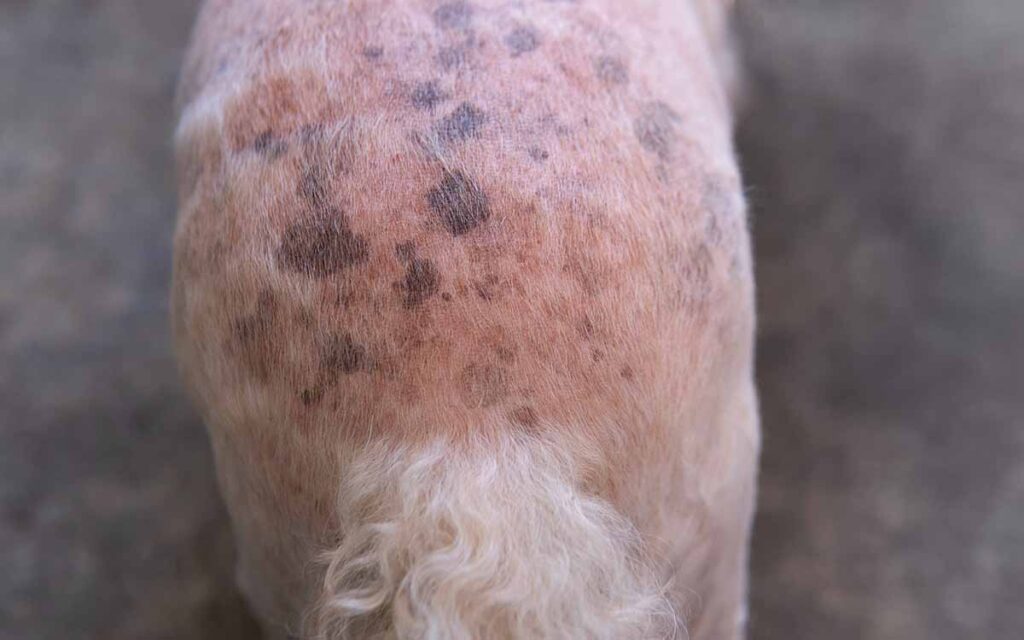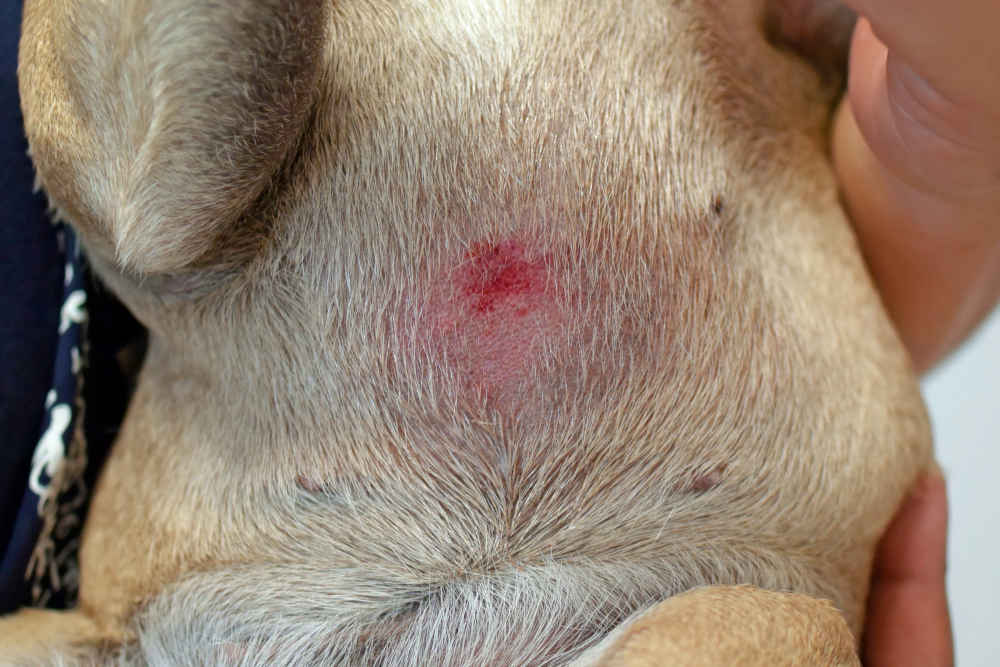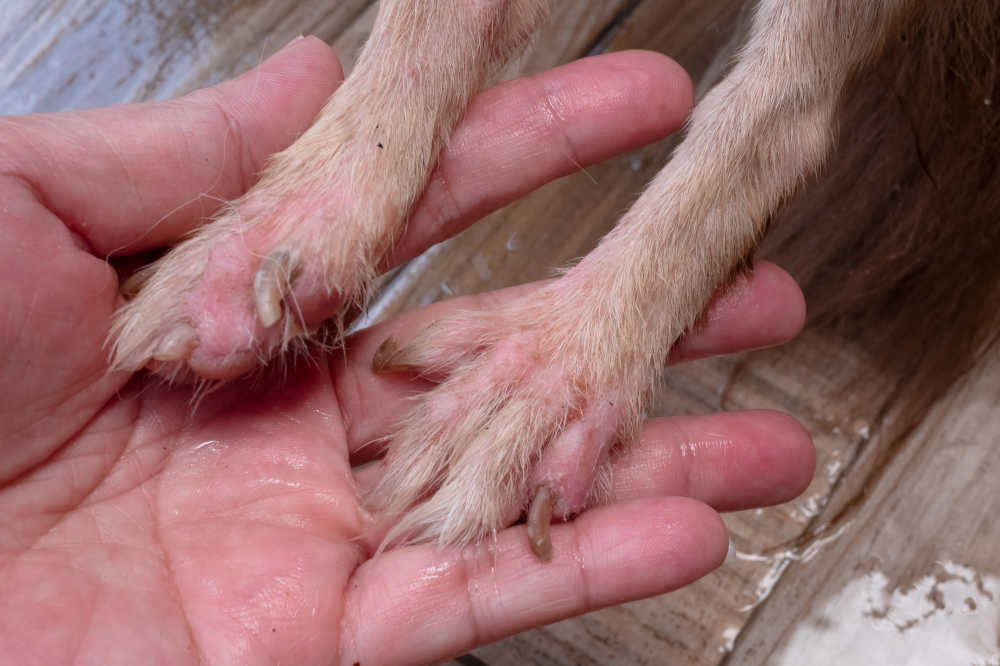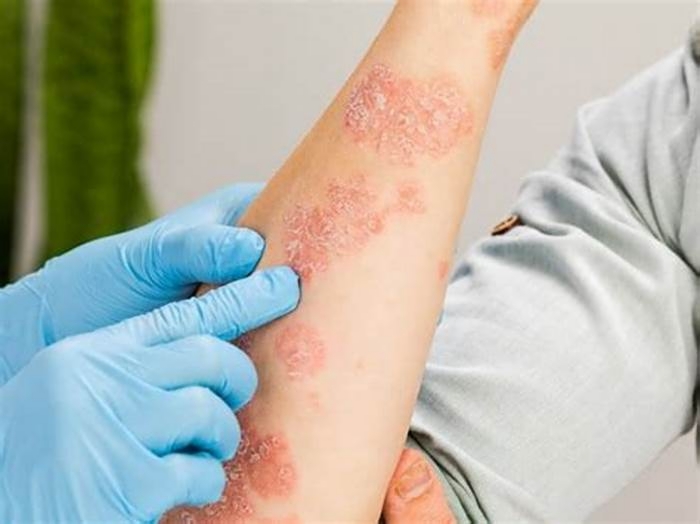What does a dog belly rash look like

Rashes on Your Dogs Belly
Rashes on a dogs belly may look alarming and uncomfortable, but they are quite common. These dog belly rash bumps and redness you see can have a variety of causes, from a simple bacterial skin infection to a more serious underlying condition, such as Cushings disease.
If left untreated, your dogs belly rash could develop into an unpleasant skin infection that will require veterinary care and cause your dog discomfort.
Here is what you need to know about your dogs belly rash, including the causes, symptoms, and treatment options available.
What Causes Dog Belly Rashes?
Your dogs skin protects his body from the outside world, acting as a barrier between his internal organs and harmful organisms. We might think of skin as being tough and resistant, but it is actually very sensitive to changes in both your dogs body and the environment.
One of the ways the skin shows this sensitivity is through rashes.
There are several causes of rashes in dogs:
- Skin infections
- Inflammatory conditions
- Allergies (which many times are genetic)
- Parasites
- Genetic
- Hormonal imbalances and endocrine conditions
- Environmental causes (such as poison ivy or other plants)
Infections
Sometimes cuts can open the skin barrier to infections. Many of the causes of rashes in dogs are the result of bacterial, fungal, or yeast infections.
Bacterial skin infections are called pyoderma, which translates from Greek to pus and skin. Pyoderma typically causes lesions that look like pimples and can also cause crusty, dry, flaky skin. Hair loss and itchiness can also occur.
Your dog can get pyoderma as a result of trauma to the skin, like an abrasion or cut, excessive moisture, or as a secondary condition. Puppies are prone to puppy pyoderma in areas without a lot of hair, such as their underarms and groin. Hereditary factors can also play a role in skin infections for both puppies and adult dogs.
Fungal infections, such as yeast infections and ringworm, are also common. Yeast dermatitis is a skin condition caused by yeast infections. It is also known as Malassezia dermatitis and is caused by the fungus Malassezia pachydermatis. Symptoms of this condition include thickened skin; changes in skin pigmentation; a musty smell; itching; redness; scaling, crusty, flaky skin; and chronic ear infections.
Ringworm is characterized by circular lesions, which can appear red and scabbed. Hair loss is common, and while these rashes are usually not itchy, they can become inflamed, and the condition can be passed to people and other pets.
Allergies
Allergies can also cause rashes on your dogs belly. Environmental allergies, like contact dermatitis or reactions to something on the ground like fertilizer, cleaning products, poison ivy, or other irritants, flea allergy dermatitis, and food allergies, food sensitivities, and food intolerance can lead to itchy bumps and rashes. When your dog itches and scratches, he opens his skin up to infections, which can lead to a rash or complicate an existing rash.
Allergies can have a wide array of symptoms, from digestive upset to skin conditions such as itchiness, hair loss, redness, irritation, and chronic skin infections. Talk to your veterinarian if you suspect that your dog might have an allergy.
Pests and Parasites
Pests and parasites could also be the cause of your dogs rash. Fleas, mites, and ticks can cause irritation, exposing your dog to bacteria, yeast, and fungal infections. Demodex mites, walking dandruff, flea allergy dermatitis, and sarcoptic mange (caused by the Sarcoptes scabiei mite) can all cause rashes on your dogs skin, including her belly and groin area.
Genetic
Some dogs are more prone to rashes than others. Breeds that are predisposed to skin problems, such as Cocker Spaniels, German Shepherd Dogs, Labrador Retrievers, Bulldogs, Doberman Pinschers, and Standard Poodles, may be at an increased risk of developing rashes on their bellies and elsewhere.
Golden Retrievers, for instance, can get a rare condition called congenital ichthyosis, which causes scaling of the skin on the abdomen. Arctic breeds, for example the Samoyed, can develop zinc-responsive dermatosis, and Cocker Spaniels are prone to primary seborrhea (dandruff).
Hormonal Imbalances and Conditions (Endocrine Disorders)
Most concerning, however, is the possibility that your dogs belly rash could be a sign of an underlying condition, such as hypothyroidism or Cushings disease. These diseases cause hormonal imbalances in your dogs body, and some of the first obvious symptoms are often skin conditions, such as thinning or loss of coat and changes to the quality of the skin.
You can help your veterinarian catch these diseases early by observing your dog for any changes in coat quality, drinking and urination habits, as well as rashes, hair loss, and dry skin.
Symptoms of Belly Rash
Rashes on your dogs belly can present in a few ways. Perhaps the most common is pyoderma, which is characterized by pimple-like lesions; dry, scaly, crusty skin; hair loss; and itchiness.
Your dogs skin may also appear red and inflamed, weepy, or scabbed. Yeast infections can result in a yeasty smell, and fungal infections like ringworm often have a distinct, circular pattern to the lesions.
Find out more about the causes of dry skin on dogs
Diagnosing Your Dogs Belly Rash
The best way to determine the cause of your dogs belly rash is to make an appointment with your veterinarian, who will perform some diagnostic tests based on your dogs age, breed, overall health, and symptoms.
Veterinarians use skin samples, blood tests to detect underlying conditions, fungal cultures, antibiotic sensitivity tests, and in some cases, allergy testing to accurately diagnose skin conditions in dogs. Your veterinarian may refer you to a dermatologist for further testing and treatment.
Treating Belly Rashes
Once your veterinarian has diagnosed the cause of your dogs belly rash, she will discuss your treatment options.
Bacterial skin infections are typically treated with a course of antibiotics. Your veterinarian may want to perform an additional test to determine the best type of antibiotic to treat your dogs rash and avoid building up antibiotic resistance, and could prescribe you with medicated shampoos or scrubs to help manage the infection.
Yeast and other fungal infections are treated with antifungal medications and shampoos.
Allergies, depending on the cause, can be more difficult to treat, and may involve treating both the allergy and any secondary skin infections that developed. Your vet may recommend a dog skin soother balm to help ease the discomfort.
Conditions such as hypothyroidism and Cushings disease, like allergies, require treatment of the condition itself and the skin rash. Your dog may require additional blood tests and follow-up monitoring.
In some cases, your dogs belly rash could be the result of a resistant infection, such as methicillin-resistant Staphylococcus aureus (MRSA). It is very important to follow your veterinarians instructions about treating resistant infections, and you will need to be patient, as it may take time for the infection to heal.
Rashes on your dogs belly are not usually serious, but they do require medical attention. As a note of caution, some rashes can be transferred to people, like poison ivy or ringworm, so be careful to avoid touching the rash yourself, and make an appointment with your veterinarian today to get an accurate diagnosis for your dogs rash and to ensure that he stays happy, healthy, and active.
Dog Heat Rash: What It Looks Like (with Pics) & How to Treat

This article was updated on December 6th, 2022
Heat rash is an issue I encounter fairly regularly in my practice, especially in the summer months. Many owners like to get outdoors with their canine companions when the sun is beaming down. However, many owners dont take into account the effects that extreme heat can have on dogs and, as a result, many dogs are rushed to their veterinarians for emergency treatment after they overheat.
Unfortunately, this is still an issue that many owners are oblivious to, but this article aims to educate owners and will go into detail on how to know if your dog has heat rash and what you can do at home to help your dog.
What is Dog Heat Rash?
Prolonged exposure to very hot temperatures results in irritation to the skin and changes in the skins appearance. Dogs dont sweat in the same way humans do and instead regulate their body temperature through panting; their thick coats can leave them susceptible to the effects of overheating.The main cause of heat rash in dogs is overexposure to heat or direct sunlight.
Below are the most common symptoms seen with heat rash:
- Red inflamed skin
- Itchy skin persistent scratching and licking
- Ulceration, pimples and/or pustules on the skin
- Scabbing of the skin
- Bleeding
- Smelly skin
The effect of extreme heat can also have a negative impact on your dog as a whole, resulting in:
- Lethargy and feeling unwell
- Dehydration.
Damage to the skin can also result in secondary bacterial or fungal infections, further exacerbating the issue.
Heat rash affects dogs of all shapes and sizes, but overweight dogs or dogs with very wrinkly skin are particularly vulnerable. Dogs with more skin folds such as shar peis, bulldogs and pugs are often at a higher risk of developing heat rash.
What Does Dog Heat Rash Look Like? (With Pictures)
Heat rash can take various forms depending on the severity and area of the body affected. The general appearance is that of red, inflamed and sometimes raised skin such as that shown in the photos below:
1. Mild Heat rash slight redness to the skin and blotchy appearance. Mild cases of heat rash may be of little concern. If your dogs skin is only mildly reddened and they are only scratching at themselves occasionally then the problem will likely resolve itself within a few days, especially if you implement some of the home remedies we will cover later in this article.

2. Moderate heat rash more red appearance, irregular and uneven skin surface, as seen on the picture below:

3. Severe heat rash bright red, ulcerated skin often with hair loss and signs of secondary bacterial infection.
If your dog has very red, ulcerated skin and they are frantically scratching at themselves then this poses a concern and they should be taken to the veterinarian immediately. Signs of infected skin such as pustules or a foul smell are also a reason to seek veterinary intervention.
If your dog is unwell in any other way, such as showing signs of lethargy, vomiting and dehydration then they may also have heat stroke alongside a rash. This should be treated as an emergency and you should take them to the vet immediately.Below is a picture showing a severe case of heat rash on a dog:

4. Focal heat rash sometimes heat rash can occur in a more local, specific area of skin rather than affecting the whole skin more broadly.

How to Tell if Your Dog Has a Heat Rash
While it can be difficult to say for sure if your dog has heat rash, the sudden appearance of any of the symptoms above shortly after spending time in a hot environment makes heat rash quite likely. Mild cases of heat rash may respond to applying a cool towel or soothing cream to the affected areas of your dogs skin if they improve then its likely that your dog is suffering from heat rash.
4 Steps You Can Take at Home to Help Your Dog
While severe cases of heat rash will require veterinary attention, there are a few steps you can take at home to help alleviate the symptoms of heat rash:
- Put your dog somewhere cool. Avoid direct sunlight and heat and try to cool them down as much as possible. Placing them in a bath of cool water or directing a fan to blow cold air in their direction may help.
- Apply a cool towel or cold compress to the affected areas. The sooner you can do this, the more effective it will be. This will help to cool down the affected areas of skin before symptoms worsen.
- Apply aloe vera to the affected areas. This can be either directly squeezed from the plant or in the form of a soothing aloe vera cream (See this cream on Amazon). Other soothing creams may work too.
- Call your vet: if no improvements are seen after 24-48 hours, call your vet: delaying veterinary treatment could endanger your dog and make the issue a lot worse than it is now.Even mild cases of heat rash can turn into a more complex skin infection or irritation.
Is Dog Heat Rash Serious? Is My Dog Suffering?
Mild cases of heat rash are not likely to cause your dog any more discomfort than a subtle itchy sensation, which can be treated by the remedies we will cover in this article.However, more serious cases of heat rash where the skin is very inflamed and damaged are likely to cause extreme discomfort to your dog. Itching and licking at affected areas results in more damage and a vicious cycle develops. Damage to the outer layers of the skin also allows bacterial or fungal infections to take hold.
Exposure to extreme heat can be harmful to your dog in other ways too. Aside from a rash developing on the skin, dogs can develop heat stroke. This is a serious condition in which your dog overheats, becomes dehydrated and lethargic. Therefore, its important to not only be aware of symptoms of heat rash but also heat stroke as often the two come hand in hand.
Can My Dog Recover from Dog Heat Rash Without Vet Treatment?
Your dog may be able to recover from mild cases of heat rash if you implement the steps above. However, if the symptoms are persisting more than 48 hours or are getting worse then you must take your dog to see the vet immediately as its likely that they require stronger treatment.
When to Call Your Veterinarian
If your dog has more than a moderate form of heat rash (based on the pictures above), or if you think there are signs of skin infection such as pustules or a foul smell then veterinary intervention is required. A heat rash that isnt responding to the home remedies discussed above will also require help from your vet.
Its also important to be aware of the symptoms of heat stroke as these conditions often go hand in hand with a dog that has overheated. Any signs of lethargy, dehydration, vomiting or even seizures should ring alarm bells and youll need to take your dog to see the vet straight away.
How Can the Vet Help with Dog Heat Rash? How Much Will It Cost?
For those more severe cases of heat rash that havent responded to home remedies then the vet can help out.
Vet Diagnosis
Diagnosis of heat rash is challenging because it can look very similar to other skin diseases such as allergic dermatitis and parasitic infection. The diagnosis is made by ruling out other causes and by assuming heat rash is the cause based on the information you provide the vet, such as whether your dog has spent a lot of time in warm weather recently.
Various skin tests can be performed if necessary, such as skin scrapes and hair plucks to look at the structure of the skin under the microscope and determine a cause. However, for the most part treatment can be started without too many tests being performed. The treatments of heat rash are very similar to other skin diseases.
Vet Treatment
Your vet will likely provide some sort of anti-inflammatory medication to your dog to help reduce the redness and irritation in his skin. This may be in the form of oral steroids or topical steroid creams such as hydrocortisone.
In cases where secondary bacterial or fungal infection is suspected, your vet will likely dispense antibiotics or antifungal treatments these may be in the form of topical creams or oral medications.
The cost of treatment will depend on the severity of the rash present but most topical treatments and steroids arent overly expensive. Expect a bill between $50-200 depending on how bad your dogs rash is and how well your dog responds to treatment.
What you Should Know Before the Vet Visit
Theres a few questions that your vet will likely ask you should you visit for an appointment and it helps to have the answers prepared in advance. Questions they may ask include:
- Has your dog been exposed to extreme heat and/or direct sunlight recently? If so, for how long?
- How long has your dog had a rash?
- Is your dog itching or chewing at themself?
- Is your dog displaying any other symptoms? Are they well in themself?
- Have you tried any treatments at home for your dogs rash?
Prevention Methods for Dog Heat Rash
Prevention of heat rash revolves around reducing your dogs exposure to extreme heat and direct sunlight. Keep your dog well hydrated and cool, especially on very warm summer days. Only take your dog out for walks early in the morning or late in the evening when its warm outdoors and make sure they have plenty of water available.
Typical Recovery Time/Prognosis for Dog Heat Rash
Dogs with heat rash typically make a quick recovery if treatment is started early. Dogs with mild to moderate heat rash will often show a marked improvement in a few days, more severe cases of heat rash where secondary bacterial infection of the skin is present may take a couple of weeks.
Generally heat rash isnt life-threatening but the other effects of heat exposure can be. Should you notice your dog appearing unwell and lethargic then seek veterinary advice immediately as they may be suffering from heat stroke.
What Looks Like a Heat Rash, but is Not a Heat Rash
The symptoms listed above are not exclusive to heat rash and many other skin conditions can look very similar. For example:
1. Allergic dermatitis inflammation of the skin due to an allergic reaction can look very similar to heat rash; redness, pimples, scratching etc are all symptoms of allergic dermatitis and so it can be easy to confuse these conditions.

2. Hot spots. Hot spots, technically known as acute moist dermatitis, are red, inflamed areas of skin that can seem to appear overnight. These spots may occur anywhere on a dog but are most common behind and under the ear, legs, and on the hips. The area will be moist and typically have some purulent oozing. Often there is matted fur covering and hiding the hot spot. Learn more about hot spots in dogs.

While either of these conditions could be the cause of your dogs recent rash, if your dog has recently spent time outdoors in the heat then a heat rash is very likely.
Dog Heat Rash FAQs with the Vet
Where is Heat Rash Most Often Seen?
Heat rash tends to affect the areas of the skin where it is thinnest, most sensitive and hairless as well as areas when the skin is folded on itself. The most common areas include, but are not limited to:
- belly,
- groin, and
- armpits.
How Does a Heat Rash Look on a Dog?
Heat rash can take many forms depending on the severity of the condition. It often appears as a reddened, ulcerated area of skin. The skin may appear uneven on the surface or even have pustules present indicating a secondary bacterial infection.
What is the Fastest Way to Get Rid of a Dog Heat Rash?
Cool your dog down as soon as possible and apply aloe vera cream.
How Long Does a Dog Heat Rash Last For?
This depends on how severe the case of heat rash is but usually the symptoms will subside within a week or two, sooner if the correct treatment is started.
Does Vinegar Help a Dog Heat Rash?
While vinegar diluted 50/50 with water may help, I wouldnt recommend it as it could be too harsh on your dogs skin, especially if they have sensitive skin.
Does Baking Soda Help a Dog Heat Rash?
Baking soda when combined 50/50 with water to form a thick paste can have a soothing effect when applied to your dogs skin. However, this probably wont be very effective for severe cases of heat rash.
Does Benadryl Help a Dog Heat Rash?
While Benadryl may be useful in treating a rash, it will likely only be effective in cases where the rash is caused by an allergy since this medication is an antihistamine. Benadryl will likely have little effect for dogs with heat rash.
Can I Put Neosporin on My Dogs Heat Rash?
Neoporin is an antibiotic ointment that may be of some benefit in preventing bacterial infections in dogs with heat rash, however it is no substitute for proper veterinary intervention.
Should You Moisturize a Dog Heat Rash?
Yes, keeping a dogs skin moistened when they have heat rash is important in preventing any further damage to the skin.
Alex Crow, VetMed MRCVS, is an RCVS accredited Veterinary surgeon with special interests in neurology and soft tissue surgery. Dr Crow is currently practicing at Buttercross Veterinary Center in England. He earned his degree in veterinary medicine in 2019 from the Royal Veterinary College (one of the top 3 vet schools in the world) and has more than three years of experience practicing as a small animal veterinarian (dogs and cats).
View all posts
Disclaimer: This website's content is not a substitute for veterinary care. Always consult with your veterinarian for healthcare decisions. Read More.









